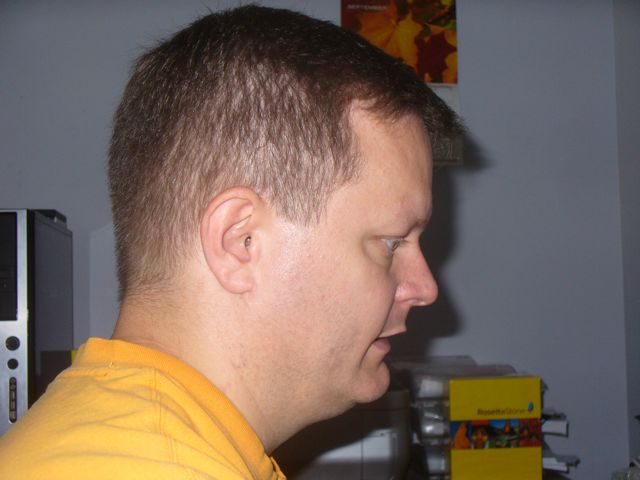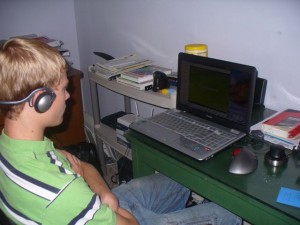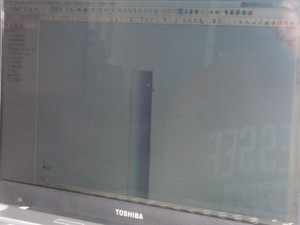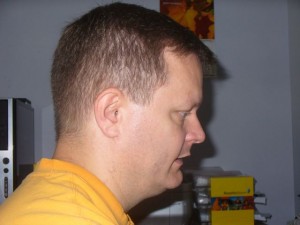
Have you ever wondered, who creates all the cool stuff in the world around us? Who thinks up these great gizmos? Well, today I found the answer. It’s the kind of person that Jeff Sharpe, the man I met with, is. They are the mechanical engineers, the unsung heroes of the world. Ever heard of a new toy called the iPhone 4? You have them to thank. Are you going to play a game of Call Of Duty 3 on your Xbox 360 after reading this? They made it happen. In fact, just about everything you touch during the day was at one time thought up by one of these geniuses. However, don’t think that they just whip out ideas like movies out of Hollywood. An idea as simple as a six-inch long mechanical pencil probably took a group of guys weeks, if not a couple of months, to perfect. Today, I got to experience what that is like. Today, I became a mechanical engineer.
 Dad drove me to Jeff’s house sometime around nine, and we got moving; however, we didn’t get our hands dirty right away. Seeing as usually, a person has to have a degree or two before becoming a mechanical engineer, Jeff put me through a twenty minute c.c.c. (computer crash course) on the program we would be using, and when it was finished, my head felt about ready to burst. It was a click this here and a tab that there, here a click, there a tab, everywhere a click, tab. But I did grasp almost all of it, and I was ready for whatever Jeff had in store for me. I thought. Since his job has to do with designing stuff, he let me decide between creating a weight rack, or a swing set. I couldn’t choose, so Jeff chose the swing set for me. I figured hey, it’s a swing set; it’s not some foreign tank infiltrator for the army. Takes a couple hours to whip up and we’re done, right? Ha. Ha ha. Ha ha ha. We started off trying to figure out the dilemma that awaited Mr. David the Engineer. We made it clear that this wasn’t for two million schools across America, it was for my own private use. And I wanted the swing to be designed as tall as possible (within reason), so I could really get pumping.
Dad drove me to Jeff’s house sometime around nine, and we got moving; however, we didn’t get our hands dirty right away. Seeing as usually, a person has to have a degree or two before becoming a mechanical engineer, Jeff put me through a twenty minute c.c.c. (computer crash course) on the program we would be using, and when it was finished, my head felt about ready to burst. It was a click this here and a tab that there, here a click, there a tab, everywhere a click, tab. But I did grasp almost all of it, and I was ready for whatever Jeff had in store for me. I thought. Since his job has to do with designing stuff, he let me decide between creating a weight rack, or a swing set. I couldn’t choose, so Jeff chose the swing set for me. I figured hey, it’s a swing set; it’s not some foreign tank infiltrator for the army. Takes a couple hours to whip up and we’re done, right? Ha. Ha ha. Ha ha ha. We started off trying to figure out the dilemma that awaited Mr. David the Engineer. We made it clear that this wasn’t for two million schools across America, it was for my own private use. And I wanted the swing to be designed as tall as possible (within reason), so I could really get pumping.
Now that we had the criteria down, we had to choose what materials were going to go into this. Jeff had already decided on just a regular simple design, with two uprights stuck in the ground and a crossbar connecting them. The first thing we had to decide was what shape to use. We narrowed it down to three finalists: circle, square, and rectangle. Since a swing goes back and forth, there’s a ton of stress on the back and front of the structure, but we thought there also may be some torque (from swinging sideways) as well, so we chose the circle. Jeff owns a book of a million materials, which he goes to in every one of his projects, and we used that to choose the length and diameter. Because we wanted a 20-foot-tall swing, and because we wanted at least four feet in the ground, we got a 24 foot steel tube 5/8 in. thick. Then, for the crossbar, we picked a steel tube five feet long. And all that took a couple hours to accomplish.
I was starting to see why it takes so long for great ideas to happen. All of the variables that go into a big projects make it insanely hard. Still, we were moving quite fast, and we had a good part finished. I thought we would get done before lunch. Ha. Ha ha. Ha ha ha. We hadn’t done a thing on the computer yet, and the tough part was still ahead. So we had the frame done. Next, we wanted something to hold the seat, i.e. rope, wire, chain, yarn, etc. We immediately ruled out any type of chain, because it rusts and it’s a pain in the neck to hold on to. It seemed that some kind of rope was our only other option, so Jeff quickly went to a website that sells pretty much anything construction, and we looked for rope. We needed something that would hold up against rain, sun, wind, and stress. The only type that fulfilled all of those functions was polyester rope, so that was what we chose.
The only thing we had left to pick was how we would connect the rope to the crossbar. We had several options, with no obvious answer. One thing we could do would be to simply wrap the rope around the top bar a few times and then clamp it off. Another option would be to drill a hole vertically through the bar, insert an I-hook, and stick the rope through that. Still a third choice is a clamp that fits around the crossbar. It has a hole below for fitting the rope through, and you can tighten and loosen it at will. So if you happen to miscalculate, you can just undo it, slide it down a few inches, and your problem’s solved.
 That happened to be the one we picked, and we had our design finally finished. How, you ask, did we move it to the computer and make it a 3D reality? It all comes back to that program that I briefly mentioned at the beginning. This was almost exclusively Jeff’s territory, although I did help some. First, he drew a circle the exact diameter of our mental swing set’s frame (the program allows you to change dimensions with a click of the mouse. Then, he elongated it to a length of twenty four feet (another plus of the program is the fact that you can zoom in and out, so we didn’t have to keep moving up and down the tube to see it). He duplicated the tube, and made the crossbar. Now the set was taking shape, and elation was filling my soul. Once again, I seemed to see the end in sight. Ha. Ha ha. Ha ha ha. (I bet you saw that coming, didn’t you?)
That happened to be the one we picked, and we had our design finally finished. How, you ask, did we move it to the computer and make it a 3D reality? It all comes back to that program that I briefly mentioned at the beginning. This was almost exclusively Jeff’s territory, although I did help some. First, he drew a circle the exact diameter of our mental swing set’s frame (the program allows you to change dimensions with a click of the mouse. Then, he elongated it to a length of twenty four feet (another plus of the program is the fact that you can zoom in and out, so we didn’t have to keep moving up and down the tube to see it). He duplicated the tube, and made the crossbar. Now the set was taking shape, and elation was filling my soul. Once again, I seemed to see the end in sight. Ha. Ha ha. Ha ha ha. (I bet you saw that coming, didn’t you?)
It was time for lunch, so I hurried down to the table for replenishing. Of course, it was delicious. Afterward, Jeff and I moved to another stage in the creation of our prize; the dreaded stress test. This is a different section of Jeff’s computer program. In layman’s terms, it divides your object into tons of tiny little pieces. Then, the computer does a complicated formula with each one of these pieces. The result? You learn the stress. The smaller the pieces, the simpler the formula, but the the computer has to do more of them. And vice versa the other way. Here, I’ll try to put it a different way. If you wanted to find the area of a circle, you could replace it with a square. That would give you a very general idea of the area very easily. If you did the same thing with a octagon, you would have a harder formula, but a better idea of the area. That’s how it works. And sometimes, if you want a very exact stress test, the computer can do more than 50,000 mathematical sequences in under a minute. Good thing some brilliant engineer invented the computer, huh?
The computer had run through the formulas, and we were ready to test the swing set design. First, Jeff exaggerated the level of stress by about 15 times. He did this so that he could easily see where the stress was occurring. As soon as he exaggerated it, you could see where the stress was the worst. The upright poles were bending like Play-Doh™ in a kid’s hands, and you could really tell where the poles were being stressed the most. Like Jeff had surmised, almost all of it was at the bottom of the poles and around the clamps. But when he minimized the stress level to its original state, you could barely tell that the structure had budged.
There was a lot of cool stuff I was learning from Jeff, but the coolest part of it by far was the fact that what he had taught me doesn’t have to be limited to swing sets and things like that. You can use it to create and invent anything you want, anytime you want to. You could make a new type of iPhone, one with x-ray vision eyes or something. Literally anything is possible when you boot up your computer, load that program, and start working.
We were almost out of time, so I asked Jeff if might be able to ask a few questions before leaving. He agreed, and I commenced to riddle him with questions. My beginning query was why he homeschools (obviously, my parents homeschool me, but I just wanted to get his reason). He said that he has two reasons: number one because he feels like the public schools aren’t efficient enough at educating kids (in other words, there’s a lot of time wasted), and number two, the morality in the schools is terrible, with a lot of peer pressure. My next question was why Jeff and his family move around so much. Sorry about not giving much background, but they’ve lived in Dallas, Houston, Charlotte, Knoxville, and Chattanooga. He said that the reason is both necessity (his job) and preference. He has liked it, although he doesn’t have any plans of moving in the near future. Another question I fired at him was what it is like being the dad of four. His reply was this: “I like it. It can be hectic, but it can also be quite peaceful; you can get both ends. Most of the time it’s pretty good fun”. The last question I asked Mr. Jeff was (you know it) his wisest and unwisest decisions. He said that his three wisest have been choosing to follow the Lord, marrying his wife, and learning to listen to criticism; in other words, not rejecting tips because of the person that they come from.
 I thought that I would be leaving , but fortunately, dad called to say that he would be about 15 minutes late, so I had time for a little fun and games before I left. Earlier in the day, Jeff had said that I could fool around on the computer with that program. I did, but what I had made somehow got erased. However, I re-created what I had made earlier, with a few modifications. Then, with the help of Jeff’s firstborn Trevor, I made my creation 3D. It really wasn’t that hard, and by the time dad arrived, I had finished and was outside kicking a soccer ball around with Trevor and his brother, Kyle. In case you’re wondering, my creation was a crude but pretty cool-looking tank. When I asked Mr. Jeff what he thought about it, he said, “cute and childish”. Seeing as he works with the real thing, I couldn’t blame him for saying that, but it wasn’t bad seeing that I whipped it out in under half an hour.
I thought that I would be leaving , but fortunately, dad called to say that he would be about 15 minutes late, so I had time for a little fun and games before I left. Earlier in the day, Jeff had said that I could fool around on the computer with that program. I did, but what I had made somehow got erased. However, I re-created what I had made earlier, with a few modifications. Then, with the help of Jeff’s firstborn Trevor, I made my creation 3D. It really wasn’t that hard, and by the time dad arrived, I had finished and was outside kicking a soccer ball around with Trevor and his brother, Kyle. In case you’re wondering, my creation was a crude but pretty cool-looking tank. When I asked Mr. Jeff what he thought about it, he said, “cute and childish”. Seeing as he works with the real thing, I couldn’t blame him for saying that, but it wasn’t bad seeing that I whipped it out in under half an hour.
By the time dad showed up and spirited me off to soccer practice, Jeff and I hadn’t finished the swing set (we probably had another half-day’s work before that happened), but we had gotten far enough into it for me to see what the life of a mechanical engineer is like. Jeff said that he usually doesn’t work from home, but even if we had been in an office, I think I still would have had a blast. It was definitely one of the coolest days of my life, and the most fun thing that I’ve ever done on a computer (yes, even better than all those games and sports updates). And who knows? maybe one day I’ll be able to help invent something like a shrinking machine or a IQ booster! Yeah, I know; ha, ha ha, ha ha ha.